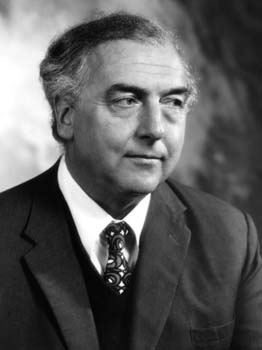Related Research Articles

Francis Harry Compton Crick was an English molecular biologist, biophysicist, and neuroscientist. He, James Watson, Rosalind Franklin, and Maurice Wilkins played crucial roles in deciphering the helical structure of the DNA molecule.
June 8 is the 159th day of the year in the Gregorian calendar; 206 days remain until the end of the year.

James Dewey Watson is an American molecular biologist, geneticist, and zoologist. In 1953, he co-authored with Francis Crick the academic paper proposing the double helix structure of the DNA molecule. Watson, Crick and Maurice Wilkins were awarded the 1962 Nobel Prize in Physiology or Medicine "for their discoveries concerning the molecular structure of nucleic acids and its significance for information transfer in living material".
The year 1916 involved a number of significant events in science and technology, some of which are listed below.

Fellowship of the Royal Society is an award granted by the Fellows of the Royal Society of London to individuals who have made a "substantial contribution to the improvement of natural knowledge, including mathematics, engineering science, and medical science".

The University of Bucharest, commonly known after its abbreviation UB in Romania, is a public university founded in its current form on 4 July 1864 by a decree of Prince Alexandru Ioan Cuza to convert the former Princely Academy into the current University of Bucharest, making one of the oldest modern Romanian universities. It is one of the five members of the Universitaria Consortium.
The year 1962 in science and technology involved some significant events, listed below.
Timothy John Mitchison is a cell biologist and systems biologist and Hasib Sabbagh Professor of Systems Biology at Harvard Medical School in the United States. He is known for his discovery, with Marc Kirschner, of dynamic instability in microtubules, for studies of the mechanism of cell division, and for contributions to chemical biology.
Reverse learning is a neurobiological theory of dreams. In 1983, in a paper published in the science journal Nature, Crick and Mitchison's reverse learning model likened the process of dreaming to a computer in that it was "off-line" during dreaming or the REM phase of sleep. During this phase, the brain sifts through information gathered throughout the day and throws out all unwanted material. According to the model, we dream in order to forget and this involves a process of 'reverse learning' or 'unlearning'.

The Francis Crick Medal and Lecture is a prize lecture of the Royal Society established in 2003 with an endowment from Sydney Brenner, the late Francis Crick's close friend and former colleague. It is delivered annually in biology, particularly the areas which Francis Crick worked, and also to theoretical work. The medal is also intended for young scientists, i.e. under 40, or at career stage corresponding to being under 40 should their career have been interrupted.

The Cancer Research UK London Research Institute (LRI) was a biological research facility which conducted research into the basic biology of cancer.

The University of Warsaw is a public university in Warsaw, Poland. Established in 1816, it is the largest institution of higher learning in the country offering 37 different fields of study as well as 100 specializations in humanities, technical, and the natural sciences.

The Honourable John Murdoch Mitchison FRS, FRSE was a British zoologist.

Sean Roberts Eddy is Professor of Molecular & Cellular Biology and of Applied Mathematics at Harvard University. Previously he was based at the Janelia Research Campus from 2006 to 2015 in Virginia. His research interests are in bioinformatics, computational biology and biological sequence analysis. As of 2016 projects include the use of Hidden Markov models in HMMER, Infernal Pfam and Rfam.
Yang Dan is a Chinese-American neuroscientist. She is the Paul Licht Distinguished Professor of Neurobiology at the University of California, Berkeley and a Howard Hughes Medical Institute (HHMI) Investigator. She is a past recipient of the Alfred P. Sloan Research Fellowship, Beckman Young Investigator Award, and Society for Neuroscience Research Awards for Innovation in Neuroscience. Recognized for her research on the neural circuits that control behavior, she was elected to the US National Academy of Sciences in 2018.

The Faculty of Science of Eötvös Loránd University was founded in 1949 and it is located in Lágymányos Campus, Újbuda, Budapest, Hungary.
References
- ↑ Bretscher, Mark S.; Mitchison, Graeme. "Francis Harry Compton Crick OM. 8 June 1916 — 28 July 2004". Biographical Memoirs of Fellows of the Royal Society. 63: 159–196. doi:10.1098/rsbm.2017.0010. ISSN 0080-4606.
- ↑ "The Physicist Behind the Physicist in the New McEwan". Big Think. 2010-04-02. Retrieved 2023-07-10.
- ↑ "The Function of Dream Sleep". Francis Crick - Profiles in Science. Retrieved 2023-07-10.
- ↑ "McEwan recircuits history to create a quirky alternate 1980s universe". thestar.com. 2019-04-18. Retrieved 2023-07-10.
- ↑ "Lit Life: Ian McEwan talks androids, consciousness and Alan Turing". The Seattle Times. 2019-04-25. Retrieved 2023-07-10.
- ↑ Obituaries, Telegraph (2018-07-12). "Graeme Mitchison, scientist, mathematician, pianist and writer – obituary". The Telegraph. ISSN 0307-1235 . Retrieved 2023-07-10.
- ↑ "Graeme Mitchison - 1944 to 2018". Shene Grammar School Old Boys. 2021-03-14. Retrieved 2023-07-10.